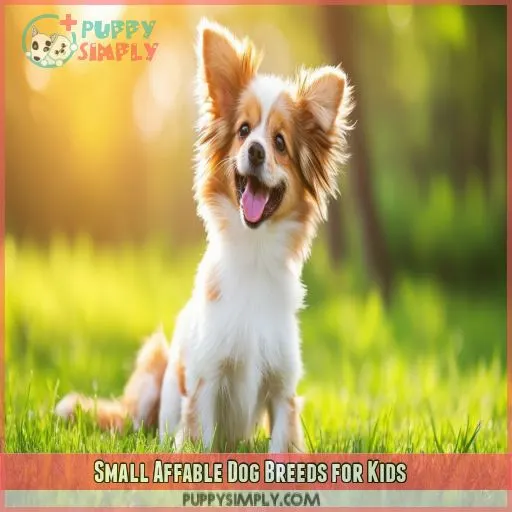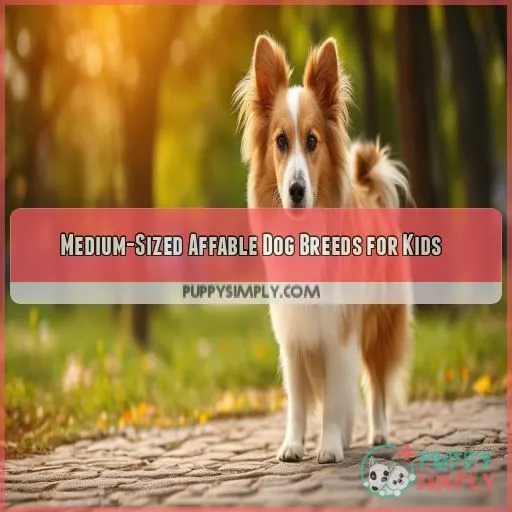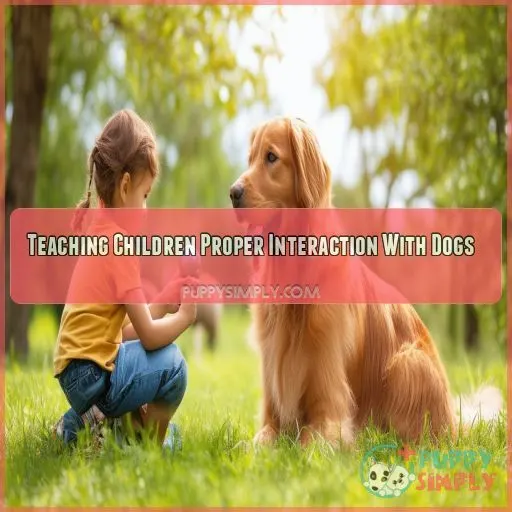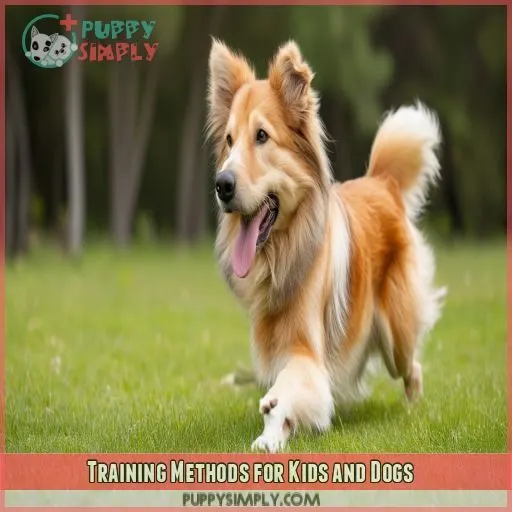This site is supported by our readers. We may earn a commission, at no cost to you, if you purchase through links.

This guide explores top picks for affable dog breeds, considering factors like temperament, size, and energy levels. From loyal Labradors to playful Beagles, you’ll discover options suited to various family dynamics.
Learn how to select the perfect furry friend that will bring joy, companionship, and valuable life lessons to your children.
Table Of Contents
- Key Takeaways
- Top Affable Dog Breeds for Kids
- Small Affable Dog Breeds for Kids
- Medium-Sized Affable Dog Breeds for Kids
- Large Affable Dog Breeds for Kids
- Affable Dog Breeds for Specific Circumstances
- Factors Influencing Affability in Dog Breeds
- Teaching Children Proper Interaction With Dogs
- Key Qualities Making a Dog Breed Suitable for Kids
- Training Methods for Kids and Dogs
- Ensuring Long-Term Compatibility and Well-Being
- Frequently Asked Questions (FAQs)
- Conclusion
Key Takeaways
- Picking the right pooch for your kiddos is like finding the perfect puzzle piece – it’s all about matching temperament, size, and energy levels to your family’s lifestyle. From gentle giants like St. Bernards to pocket-sized pals like Bichon Frises, there’s a furry friend for every household.
- Training your new four-legged family member isn’t rocket science, but it does take patience and consistency. Remember, Rome wasn’t built in a day, and neither is a well-behaved pup. Positive reinforcement is your secret weapon – treats and praise will have your pooch performing tricks faster than you can say "fetch!"
- Teaching your little ones to respect Fido’s boundaries is crucial. It’s like learning to dance – both partners need to know the steps to avoid stepping on each other’s toes (or paws, in this case). Supervise those early interactions, and you’ll be setting the stage for a beautiful friendship.
- Don’t forget, bringing a dog into your home is a long-term commitment – it’s not just a flash in the pan. Regular vet check-ups, a balanced diet, and plenty of exercise will keep your furry friend healthy and happy. After all, a healthy dog is a happy dog, and a happy dog makes for one tail-wagging good time!
Top Affable Dog Breeds for Kids
When choosing an affable dog breed for your family, consider the Labrador Retriever, Golden Retriever, Beagle, Boxer, and Bichon Frise. These breeds are known for their friendly, gentle, and patient temperaments, making them excellent companions for children.
Labrador Retriever
The Labrador Retriever is a playful and outgoing breed. They make great companions for kids. Labs are energetic and intelligent. They are always up for a game of fetch or a walk in the park.
Their golden, friendly disposition and patient, protective temperament make them loyal companions for children. Labs respond well to training and socialization, making family life easy.
Golden Retriever
Golden retrievers are a popular choice for families because they are intelligent, devoted, and easy to train.
These dogs are friendly, tolerant, and affectionate, typically weighing between 65 and 75 pounds.
Known for their gentle and loving nature, they make ideal companions for children.
Their playful attitude and eagerness to please also make them excellent candidates for training and socialization.
Beagle
Beagles are happy-go-lucky, friendly, and affectionate dogs that make great companions for children. They are energetic and curious, always up for a game or an adventure.
”’
With a weight range of 20 to 30 pounds, Beagles are typically a good size for families. Their grooming needs are minimal, but they require regular exercise to expend their energy in a positive way.
”’
Beagles are generally healthy, but as with all breeds, they have their own unique health concerns. When considering adding a Beagle to your family, it is important to do your research and find a reputable breeder or adoption resource that can match you with a dog whose temperament suits your family’s needs.
Boxer
Boxers are playful, energetic, and loyal dogs that can make great companions for kids. With proper training and socialization, they can be protective and sweet, making them excellent family pets. Consider their exercise requirements, training needs, health concerns, breed instincts, and adoption considerations before bringing one into your home.
Bichon Frise
If you’re seeking a cheerful and affectionate breed that’s also playful and friendly, the Bichon Frise could be your ideal companion. They’re known for their sensitive and calm nature, making them a great fit for families with kids. Weighing in at 10-18 pounds, these small dogs are a popular choice for those seeking a loyal and loving pet.
Small Affable Dog Breeds for Kids
Considering small, affable dog breeds for kids, Bichon Frisé, Cavalier King Charles Spaniel, Norfolk Terrier, and Brittany Spaniel are notable for their friendly and gentle temperaments. These breeds are recognized for their affectionate nature, making them perfect companions for children.
Bichon Frisé
Bichon Frises are cheerful, affectionate, and playful companions for kids. They’re friendly pets with a good-natured personality. Sociable and active, Bichon Frises excel with training and make loyal, loving additions to any family.
Cavalier King Charles Spaniel
The Cavalier King Charles Spaniel is a small, gentle, and friendly dog breed. Typically, they weigh between 13 and 18 pounds.
With a long history dating back to the 1700s, this breed has been a favorite among royalty and commoners alike.
Cavalier King Charles Spaniels are known for their affectionate temperament and lively personality, making them great companions for children.
While they are generally healthy, they may be prone to certain health issues such as heart problems and neurological disorders. Therefore, it is important to be mindful of their diet and exercise requirements.
Additionally, they are moderate barkers and shedders.
Norfolk Terrier
Norfolk Terriers are small, sturdy dogs with a fearless temperament, weighing in at around 11-12 pounds. They’re an excellent choice for families with kids due to their friendly and active nature. Here are three reasons why Norfolk Terriers are a great fit for families:
- Terrier Temperament: Norfolk Terriers are known for their playful and energetic personalities, making them ideal companions for children who enjoy outdoor activities and games.
- Small Stature: Their compact size makes them easy to manage and handle for both kids and adults. They don’t require a lot of space and are well-suited for families living in apartments or smaller homes.
- Low-Maintenance: Norfolk Terriers are relatively low-maintenance in terms of grooming and exercise requirements. They’ve a manageable coat that’s easy to care for, and their moderate energy level means they don’t need extensive daily workouts.
Brittany Spaniel
The Brittany Spaniel, a small and energetic dog breed, is an excellent choice for families with children. Weighing between 30 and 40 pounds, these dogs are known for their compact and agile build. Brittany Spaniels have a rich breed history and make devoted and obedient companions. They’re a great fit for families seeking a kind and energetic dog.
| Brittany Spaniel | Weight | Personality |
|---|---|---|
| Breed History | 30-40 pounds | Energetic, Compact, Agile |
| Health Issues | Devoted, Obedient | |
| Breed-Specific Traits | Kind |
Medium-Sized Affable Dog Breeds for Kids
When considering medium-sized affable dog breeds for kids, the Basset Hound, Brittany, Bulldog, Greyhound, and Portuguese Water Dog stand out for their temperament and sociability. These breeds offer a balance of energy, affection, and manageable size, making them suitable companions for children.
Basset Hound
The Basset Hound is a gentle, laid-back, and affectionate medium-sized dog breed that weighs between 40 and 65 pounds. Here are three key advantages of choosing a Basset Hound as a family pet:
- Temperament: These dogs are known for their calm and easygoing nature, making them great companions for children. They’re patient and tolerant, which is ideal for a busy family environment.
- Exercise Needs: Basset Hounds have moderate exercise requirements, so they can adapt well to different living situations, whether it’s a small apartment or a house with a yard.
- Grooming Requirements: Their short, smooth coat is easy to maintain and doesn’t require extensive grooming, making them a low-maintenance choice for families.
Brittany
Brittanys are energetic, compact, and agile dogs. They make great companions for kids.
Brittanys have a strong hunting instinct. They are often used as bird dogs or for upland game. With proper field training, they can become excellent retrieving dogs.
Brittanys are also known for their hypoallergenic qualities, which make them a good choice for families with allergies. Their maintenance requirements are relatively low.
This makes them one of the best dog breeds for first-time owners.
Bulldog
Bulldogs are attentive, fun-loving companions that can make great family pets. Their docile temperament and dependable nature often suit children well. However, you’ll need to be aware of their unique health concerns and exercise requirements. Bright and trainable, these medium-sized dogs can adapt to various living situations with proper care.
- Prone to respiratory issues due to their flat faces
- Need moderate exercise but can’t handle extreme heat
- Regular wrinkle cleaning is essential for skin health
- May snore or drool more than other breeds
- Typically good with children but can be stubborn during training
Greyhound
You might be surprised to learn that greyhounds make excellent family pets. Despite their racing background, these sturdy breeds are often gentle giants with a calm temperament.
They’re adaptable to various environments and respond well to obedience training. While they need regular exercise, greyhounds are generally low-maintenance and thrive in a loving home.
Proper socialization and exposure to different age groups and stimuli will help guarantee a well-rounded companion for your kids.
Portuguese Water Dog
Portuguese Water Dogs are energetic, intelligent companions that’ll keep your kids entertained for hours. They’re affable and confident, making them great for families.
While they need regular exercise and coat care, their hypoallergenic fur is a plus. These pups excel in dog training and adapt well to specific circumstances.
Teaching children to interact with these loyal friends is a breeze, truly embodying the "man’s best friend" moniker.
Large Affable Dog Breeds for Kids
If you’re looking for large affable dog breeds suitable for children, consider the Bloodhound and St. Bernard. These gentle giants are known for their patient and friendly nature, making them excellent companions for families with kids, though their size requires careful supervision and training to guarantee safe interactions.
Bloodhound
You’ll find Bloodhounds to be gentle giants with an unparalleled sense of smell. Their tracking abilities are legendary, rooted in centuries of breed history.
While affectionate, their size demands supervision around kids. Regular grooming is essential due to their droopy skin.
Be prepared for potential health issues and a stubborn streak. DNA tests can help predict traits.
With proper care, these lovable hounds make loyal family pets.
St. Bernard
You’ll find St. Bernards to be gentle giants with a heart of gold. These Alpine rescue dogs, known for their barrel collars and monastery origins, are the perfect breed for families seeking a large, affectionate companion.
While their drooling habits might give you pause, their low energy levels and patient nature make them ideal for kids.
They’re truly man’s best friend in a supersized package.
Affable Dog Breeds for Specific Circumstances
When you’re looking for a dog that fits specific circumstances, you’ve got options.
For apartment dwellers, clever breeds like Bichon Frises or Cavalier King Charles Spaniels adapt well to smaller spaces. If allergies are a concern, consider allergy-friendly breeds such as Poodles or Portuguese Water Dogs.
Rescue compatibility is high with mixed breeds, often creating unique and lovable companions. For families with sibling rivalry, patient breeds like Golden Retrievers can help foster cooperation.
Outdoor enthusiasts might prefer high-energy dogs like Labrador Retrievers or Border Collies. If you need a guard dog, look into loyal breeds like German Shepherds or Rottweilers. For those worried about separation anxiety, consider independent breeds like Basset Hounds.
Factors Influencing Affability in Dog Breeds
When selecting an amiable dog breed for your children, you must evaluate numerous key factors that impact a dog’s suitability for family life. These factors include the dog’s temperament, size, socialization needs, energy level, and grooming requirements, all of which play important roles in determining how well a particular breed will integrate into your household.
Temperament
When selecting a congenial dog for your family, temperament is paramount. You’ll want to account for breed-specific traits rooted in their history.
Some breeds are naturally more adaptable to family life, while others may require specific training to curb aggressive tendencies. It’s imperative to research health considerations and alert behaviors associated with each breed.
Logical reasoning about a dog’s potential aggressive behaviors and past attack cases can help guarantee a safe choice for your children.
Size
When choosing a dog for your family, size matters. Larger breeds like Newfoundlands may need more space and cost more to feed, while smaller breeds like Bichon Frises can adapt to apartment living. Consider your housing requirements and climate adaptability.
Whether you’re looking for a lap-sized companion or a gentle giant, there’s a "man’s best friend" for every family size.
Socialization
Beyond size, socialization plays a vital role in a dog’s affability. You’ll want to think about your home environment and child’s temperament when selecting a breed.
A well-socialized dog, whether from a breeder or rescue, will be more adaptable to your family’s activity level and any special needs.
Early exposure to various situations, including intruding strangers, can help shape your future furry friend into the perfect companion for your kids.
Energy Level
When choosing a dog for your family, energy level is a vital factor to contemplate.
High-energy dogs like Labrador Retrievers thrive with active families, while low-energy breeds such as Basset Hounds suit more sedentary households.
Align your lifestyle with your furry friend’s needs: if you’re always on the go, an energetic pup will keep up. For homebodies, indoor dogs with lower exercise requirements might be the perfect fit.
Grooming Needs
When considering a dog’s grooming needs, you’ll want to factor in coat type, brushing frequency, and shedding levels. Some breeds require more maintenance than others, which can impact their affability with children. Here’s what to keep in mind:
- Long-haired breeds might need daily brushing and professional trimming
- Short-coated dogs often shed less but may still require regular grooming
- Hypoallergenic breeds can be a great option for families with allergy concerns
Teaching Children Proper Interaction With Dogs
Teaching children proper interaction with dogs is essential for ensuring a safe and harmonious relationship between kids and their canine companions. This includes educating children about respecting dogs’ boundaries, maintaining proper hygiene, practicing safe feeding habits, and understanding canine behavior, all while emphasizing the importance of adult supervision during interactions.
Respecting Dogs
Teaching kids to respect dogs is essential for a harmonious relationship.
Encourage your children to understand dog boundaries and personal space. Show them how to approach dogs quietly and gently handle them.
Explain canine communication, like tail wagging or growling, to help kids interpret a dog’s mood.
Adult Supervision
Regarding kids and dogs, parental vigilance is key. You’ll need to maintain a watchful presence during their interactions. Constant monitoring safeguards both your child and your furry friend. Here’s why responsible oversight matters:
- Prevents accidents or misunderstandings
- Teaches proper handling and respect
- Allows quick intervention if needed
Your attentive guardianship sets the foundation for a harmonious relationship between your child and their canine companion. Remember, it’s your job to guide these interactions until they become second nature.
Hygiene
Teaching your kids proper hygiene practices when interacting with dogs is essential. Establish a routine for your children to wash their hands before and after playing with the family pet. Involve them in grooming tasks, but always under your supervision. Here’s a quick guide to essential dog hygiene practices:
| Task | Frequency | Child’s Role |
|---|---|---|
| Bathing | Monthly | Assist with rinsing |
| Nail trimming | Every 3-4 weeks | Observe and learn |
| Ear cleaning | Weekly | Hold supplies |
Safe Feeding Practices
While teaching children about hygiene around dogs is essential, safe feeding practices are equally important. Establish clear guidelines for your children regarding feeding your pet. Here are three key points to keep in mind:
- Store dog food in a secure container that children can’t access.
- Inform children about potential food allergies in dogs.
- Instruct children to refrain from giving dogs human food, which can be dangerous.
Always supervise feeding time to prevent choking hazards and guarantee proper nutrition.
Understanding Dog Behavior
Understanding dog behavior is essential for your child’s safety and the dog’s well-being. Teach your kids to recognize these common canine signals:
| Body Language | Meaning |
|---|---|
| Tail wagging | Happy or excited |
| Ears back | Fearful or submissive |
| Growling | Warning or discomfort |
| Yawning | Stress or anxiety |
When selecting a dog breed, consider temperament testing to verify age appropriateness and compatibility with your home environment. Remember, safety concerns should always be your top priority.
Key Qualities Making a Dog Breed Suitable for Kids
When choosing a dog breed for your family, certain qualities make some breeds more suitable for kids. You’ll want to:
- Emotional attachment: Dogs that form strong bonds with children
- Cognitive development: Breeds that can engage in interactive play
- Social skills: Dogs that are patient and tolerant with young ones
- Physical development: Breeds that encourage active playtime
Look for breeds with a gentle temperament and high tolerance for children’s unpredictable behavior. A good family dog should be patient, confident, and forgiving. Size matters too – larger breeds are often more sturdy and can handle rough play, while smaller breeds might be better for gentler kids. Energy levels should match your family’s lifestyle. Consider breeds known for their affectionate nature and ability to form strong emotional bonds. Safety is paramount, so opt for breeds with a history of being good with children. Remember, individual personality varies within breeds, so always meet the specific dog before making a decision.
Training Methods for Kids and Dogs
Training methods for kids and dogs should focus on teaching basic commands, using positive reinforcement, and setting clear boundaries. Professional help can be invaluable in establishing effective training routines and addressing any specific behavioral issues that may arise during the process.
Basic Commands
Teaching your dog basic commands is essential for a harmonious family life. Start with essentials like "sit," "stay," and "come."
Use clear communication and consistent boundaries to establish expectations. Reward-based training reinforces good behavior and strengthens your bond.
Always supervise interactions between kids and dogs during training sessions.
Positive Reinforcement
Once you’ve mastered basic commands, it’s time to focus on positive reinforcement. This powerful training method strengthens the bond between you, your kids, and your furry friend. By rewarding good behavior, you’ll encourage its repetition. Remember, timing is essential when using rewards. Here are some effective positive reinforcement techniques:
- Clicker training for precise reward timing
- Enthusiastic praise to boost confidence
- Carefully selected treats for motivation
- Consistent reward schedules to reinforce learning
Setting Boundaries
Building on positive reinforcement, setting boundaries is essential for a harmonious household. Establish clear expectations and consistent rules for both kids and dogs. Teach children to respect the dog’s personal space, and vice versa. Use positive reinforcement to encourage desired behaviors. Here’s a quick guide to setting boundaries:
| Boundary | For Kids | For Dogs |
|---|---|---|
| Personal Space | Don’t disturb sleeping dog | No jumping on people |
| Feeding Time | Don’t touch dog’s food | Wait for food command |
| Playtime | Gentle petting | No mouthing or nipping |
| Quiet Time | Respect dog’s rest | No barking at night |
| Mutual Respect | Ask before approaching | No resource guarding |
Professional Help
While setting boundaries is essential, sometimes you’ll need expert guidance. Behavioral specialists and canine therapists can offer customized strategies for your family’s unique dynamics.
Training academies provide structured programs to reinforce good habits, while veterinary consultations verify your dog’s health supports positive behavior.
Consider attending obedience workshops together as a family—they’re great for bonding and learning.
Ensuring Long-Term Compatibility and Well-Being
To guarantee long-term compatibility and well-being, you’ll need to contemplate several factors beyond a dog’s affability. Genetics play a vital role in determining breed health, so research potential hereditary issues. Create a home environment that caters to your furry friend’s needs, including space for exercise and rest.
Family dynamics are key; everyone should be on board with the responsibilities of pet ownership. Regular check-ups, a balanced diet, and exercise routines are essential for maintaining your dog’s health. Don’t forget mental stimulation through training and interactive toys.
As your children grow, their relationship with the dog may evolve, so teach them to respect and care for their canine companion. Some families even explore pet therapy options to strengthen the bond between kids and dogs.
Frequently Asked Questions (FAQs)
How do allergies affect choosing an affable dog breed?
Allergies can limit your options, but don’t worry! You’ll want to focus on hypoallergenic breeds that shed less. Consider poodles, bichon frises, or Portuguese water dogs. They’re friendly and produce fewer allergens, keeping sneezes at bay.
What age should children be to introduce a dog?
You should introduce a dog when your children are at least 4-5 years old. They’ll be better equipped to understand boundaries and interact safely. Before that, supervise closely and choose gentle breeds for younger kids.
Are rescue dogs suitable as affable family pets?
Imagine Sarah, who adopted a gentle Labrador mix. Rescue dogs can make wonderful family pets. They’re often already trained and socialized. You’ll need to assess each dog’s temperament individually, but many rescues are affectionate and great with kids.
How does apartment living impact affable breed choices?
Apartment living limits your options, but don’t worry! You’ll want smaller, quieter breeds that don’t need much space. Consider Cavalier King Charles Spaniels, Bichon Frises, or Pugs. They’re affectionate and adaptable to compact living spaces.
Can affable dog breeds get along with other pets?
Many affable dog breeds can get along well with other pets. You’ll need to introduce them properly and supervise interactions. Early socialization is key. Some breeds, like Golden Retrievers and Beagles, are particularly known for their friendly nature in relation to other animals.
Conclusion
Choosing an affable dog breed for your children is no walk in the park, but it’s essential for a happy home. You’ve now got a wealth of information to guide your decision, from breed characteristics to training methods.
With proper care and training, your new companion will bring joy and valuable life lessons to your children for years to come.
















